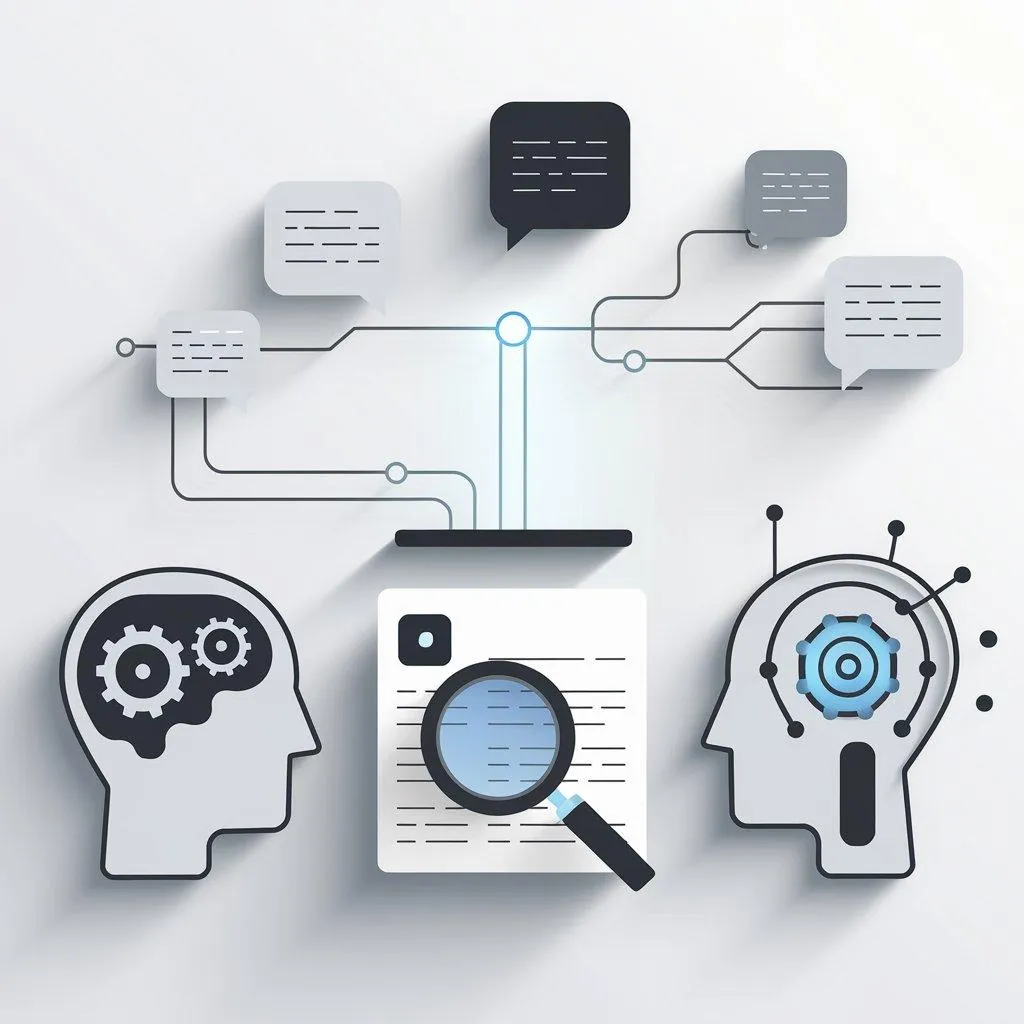Your AI Business Guy, Steven Edwards
Transforming Businesses, One Solution at a Time
AI is not just about automation and data crunching; it's about empowering businesses to make informed decisions.
Your AI Business Guy, Steven Edwards
Transforming Businesses, One Solution at a Time
AI is not just about automation and data crunching; it's about empowering businesses to make informed decisions
AI FOR BUSINESS RESOURCE CENTER

Level Up Your Thinking with AI: A Smarter Approach to Critical Thinking
Level Up Your Thinking with AI: A User-Friendly Guide to a Smarter Approach to Critical Thinking
Are you using AI to think smarter—or just faster? In today’s world of information overload and rapid technological change, critical thinking is more essential than ever. While AI (Artificial Intelligence) is a powerful tool, it should be seen as a thinking partner rather than a replacement for human intelligence.
By leveraging AI wisely, you can enhance your ability to analyze, question, and make informed decisions without falling into the trap of biases or misinformation. That’s where PIQPACC, a structured framework for critical thinking, comes in.
PIQPACC: A Smart Thinking Framework for AI Users
If critical thinking had a Swiss Army knife, PIQPACC would be it. This seven-step framework ensures that you process information logically, challenge assumptions, and draw well-founded conclusions—all while integrating AI effectively.
What is PIQPACC?
Each step in this framework helps sharpen your decision-making:
"Purpose" – What’s your end goal? Are you solving a problem, analyzing data, or making a decision?
"Information" – Is your source reliable? Avoid basing conclusions on unverified data or biased AI-generated content.
"Questions" – Are you asking the right questions to deepen your insights? AI is only as good as the prompts you provide.
"Perspectives" – Have you explored multiple viewpoints, or are you reinforcing confirmation bias? AI can generate different perspectives—use them.
"Assumptions" – What hidden assumptions might be distorting your judgment? Challenge them with AI-assisted fact-checking.
"Concepts" – Are definitions clear? Misinterpreting AI-generated results can lead to errors in thinking.
"Conclusions" – Are your takeaways fact-based or opinion-driven? AI can summarize research, but you must verify sources.
Mastering PIQPACC ensures that AI enhances your thinking instead of controlling it.
How to Use AI as a Thinking Partner (Not a Crutch)
The Right Way to Integrate AI into Critical Thinking
AI can be a powerful assistant—but only if you remain in control. Here’s how to use AI effectively while avoiding common pitfalls:
"Clarify Concepts" – AI can simplify complex topics into plain language, helping you grasp ideas quickly.
"Challenge Assumptions" – Ask AI what assumptions are embedded in an argument—it might reveal biases you didn’t notice.
"Explore Multiple Perspectives" – Use AI to generate contrasting viewpoints to break out of echo chambers.
"Bias Check" – AI inherits biases from its data. Always ask, "Could this response be biased?" and compare sources.
"Fact-Check Like a Pro" – AI can summarize research, but credible sources such as Harvard Business Review, MIT Technology Review, or government studies should always back your conclusions.
Pro Tip: AI should enhance your thinking, not replace it. Stay skeptical, verify AI-generated insights, and always apply human judgment.
Real-World Application: PIQPACC + AI in Action
Let’s say you’re researching a business trend like the rise of remote work. Here’s how to apply PIQPACC + AI effectively:
"Purpose" – Are you looking for industry trends, employee experiences, or corporate policies?
"Information" – Ask AI for recent studies but verify with sources like Harvard Business Review.
"Questions" – What impact does remote work have on productivity and company culture?
"Perspectives" – AI can provide views from CEOs, employees, HR professionals, and policymakers.
"Assumptions" – Is remote work always more productive, or does it depend on the job type?
"Concepts" – Define key terms like "productivity" and "work-life balance" for clarity.
"Conclusions" – AI can summarize research, but human judgment is required to ensure accuracy.
By combining AI-generated insights with critical thinking, you can make data-driven decisions while avoiding misinformation traps.
Expanding Your AI-Critical Thinking Toolbox
Want to level up your thinking skills even further? Here are practical strategies for AI users:
Use AI for brainstorming – AI can spark new ideas before you narrow them down.
Test AI’s reasoning – Ask it to justify its responses and check if the logic holds.
Compare AI-generated insights with expert opinions – This ensures balanced, well-rounded conclusions.
Stay updated on AI developments – The more you understand AI, the better you can use it.
Think Smarter, Lead Better
Critical thinking isn’t just a skill—it’s a competitive advantage in a world driven by AI and data. By applying the PIQPACC framework and treating AI as a strategic tool, you’ll make better decisions, avoid misinformation, and challenge assumptions
If you’re intrigued by how tools like ChatGPT revolutionize your workflow, there’s more to discover! As an AI coach, I’ve helped countless individuals and businesses leverage AI to enhance productivity, streamline processes, and spark creativity.
👉 Book a Coaching Appointment
Let’s explore how AI can transform the way you work. Whether you're new to AI or ready to scale, Steven is here to guide you.
👉 Learn More About AI with this Course
Dive into The AiMBA MasterClass and Certification to master AI tools and techniques and step into the future with confidence.

Level Up Your Thinking with AI: A Smarter Approach to Critical Thinking
Level Up Your Thinking with AI: A User-Friendly Guide to a Smarter Approach to Critical Thinking
Are you using AI to think smarter—or just faster? In today’s world of information overload and rapid technological change, critical thinking is more essential than ever. While AI (Artificial Intelligence) is a powerful tool, it should be seen as a thinking partner rather than a replacement for human intelligence.
By leveraging AI wisely, you can enhance your ability to analyze, question, and make informed decisions without falling into the trap of biases or misinformation. That’s where PIQPACC, a structured framework for critical thinking, comes in.
PIQPACC: A Smart Thinking Framework for AI Users
If critical thinking had a Swiss Army knife, PIQPACC would be it. This seven-step framework ensures that you process information logically, challenge assumptions, and draw well-founded conclusions—all while integrating AI effectively.
What is PIQPACC?
Each step in this framework helps sharpen your decision-making:
"Purpose" – What’s your end goal? Are you solving a problem, analyzing data, or making a decision?
"Information" – Is your source reliable? Avoid basing conclusions on unverified data or biased AI-generated content.
"Questions" – Are you asking the right questions to deepen your insights? AI is only as good as the prompts you provide.
"Perspectives" – Have you explored multiple viewpoints, or are you reinforcing confirmation bias? AI can generate different perspectives—use them.
"Assumptions" – What hidden assumptions might be distorting your judgment? Challenge them with AI-assisted fact-checking.
"Concepts" – Are definitions clear? Misinterpreting AI-generated results can lead to errors in thinking.
"Conclusions" – Are your takeaways fact-based or opinion-driven? AI can summarize research, but you must verify sources.
Mastering PIQPACC ensures that AI enhances your thinking instead of controlling it.
How to Use AI as a Thinking Partner (Not a Crutch)
The Right Way to Integrate AI into Critical Thinking
AI can be a powerful assistant—but only if you remain in control. Here’s how to use AI effectively while avoiding common pitfalls:
"Clarify Concepts" – AI can simplify complex topics into plain language, helping you grasp ideas quickly.
"Challenge Assumptions" – Ask AI what assumptions are embedded in an argument—it might reveal biases you didn’t notice.
"Explore Multiple Perspectives" – Use AI to generate contrasting viewpoints to break out of echo chambers.
"Bias Check" – AI inherits biases from its data. Always ask, "Could this response be biased?" and compare sources.
"Fact-Check Like a Pro" – AI can summarize research, but credible sources such as Harvard Business Review, MIT Technology Review, or government studies should always back your conclusions.
Pro Tip: AI should enhance your thinking, not replace it. Stay skeptical, verify AI-generated insights, and always apply human judgment.
Real-World Application: PIQPACC + AI in Action
Let’s say you’re researching a business trend like the rise of remote work. Here’s how to apply PIQPACC + AI effectively:
"Purpose" – Are you looking for industry trends, employee experiences, or corporate policies?
"Information" – Ask AI for recent studies but verify with sources like Harvard Business Review.
"Questions" – What impact does remote work have on productivity and company culture?
"Perspectives" – AI can provide views from CEOs, employees, HR professionals, and policymakers.
"Assumptions" – Is remote work always more productive, or does it depend on the job type?
"Concepts" – Define key terms like "productivity" and "work-life balance" for clarity.
"Conclusions" – AI can summarize research, but human judgment is required to ensure accuracy.
By combining AI-generated insights with critical thinking, you can make data-driven decisions while avoiding misinformation traps.
Expanding Your AI-Critical Thinking Toolbox
Want to level up your thinking skills even further? Here are practical strategies for AI users:
Use AI for brainstorming – AI can spark new ideas before you narrow them down.
Test AI’s reasoning – Ask it to justify its responses and check if the logic holds.
Compare AI-generated insights with expert opinions – This ensures balanced, well-rounded conclusions.
Stay updated on AI developments – The more you understand AI, the better you can use it.
Think Smarter, Lead Better
Critical thinking isn’t just a skill—it’s a competitive advantage in a world driven by AI and data. By applying the PIQPACC framework and treating AI as a strategic tool, you’ll make better decisions, avoid misinformation, and challenge assumptions
If you’re intrigued by how tools like ChatGPT revolutionize your workflow, there’s more to discover! As an AI coach, I’ve helped countless individuals and businesses leverage AI to enhance productivity, streamline processes, and spark creativity.
👉 Book a Coaching Appointment
Let’s explore how AI can transform the way you work. Whether you're new to AI or ready to scale, Steven is here to guide you.
👉 Learn More About AI with this Course
Dive into The AiMBA MasterClass and Certification to master AI tools and techniques and step into the future with confidence.
